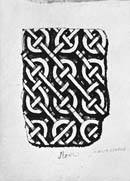Select a site alphabetically from the choices shown in the box below. Alternatively, browse sculptural examples using the Forward/Back buttons.
Chapters for this volume, along with copies of original in-text images, are available here.
Object type: Part of grave-cover(?) [1]
Measurements: Dimensions as given by Davies (1926, 19): L. 30.5 cm (12 in) W. 15.25 cm (6 in) D. Not recorded
Stone type: Not recorded
Plate numbers in printed volume: Ill. 352
Corpus volume reference: Vol 5 p. 256-257
(There may be more views or larger images available for this item. Click on the thumbnail image to view.)
From its similarity to Stow 2, the stone was evidently a fragment from a flat, rectangular or slightly tapering grave-cover decorated in low relief only on the upper surface with patterns limited to interlace. It had been recut for secondary use (Davies 1926, 19). The slab is described as differing from Stow 2 'only in having the pattern of its ornamentation more lozenge-shaped' (Boutell 1854, 3) or 'more angular' (Davies 1926, 19).
An illustration, 'a sketch', in the Ross collection (LCL, Ross MSS vol. 1 (Corringham, Well)) may depict this fragment (see Ill. 352). The context appears to imply that it was in the transepts, perhaps the south. As sketched in the Ross manuscript, only a single complete row of figure-of-eight (closed-circuit pattern F) is shown, together with truncated half rows above and below. The figures-of-eight themselves are shown as complete closed patterns, run through with a separate rectangular lattice-work of linear strands which fails to maintain a systematic regime of passing under and over. As depicted, this mechanical pattern continued in all directions off the fragment.
Completely confident assessment of this piece is hindered by the limitations of its recording. The Ross manuscript sketch might be a representation of the second fragment mentioned by Boutell and Davies. It has no recorded dimensions in the Ross manuscript, but its proportions are approximately 2:1 as Davies records. This would also give a unit size for the pattern closely similar to Stow 2. As drawn it has a superficial overall similarity to Stow 2, though in detail its closed-circuit form of figure-of-eight is alien to the local tradition best exemplified in the Lindsey covers (Fig. 14), and the lattice-work effect is created as a separate pattern. This pattern is actually more rectangular rather than more lozenge-shaped than Stow 2. Nevertheless, the sketch might be reasonably understood as a relatively incom-petent or misunderstood representation of a stone similar to Boutell's, but different enough for him to draw a distinction. If so, its date and context is probably the same as Stow 2.
Alternatively, it may be an equally or more incompetent depiction of the same stone as Boutell's engraving, i.e. of Stow 2 (Ill. 351), perhaps after it had suffered further reduction in size. In that case, Stow 4 might be Boutell's second stone, though its different decoration and inappropriate proportions argue against.
The reuse of this fragment in an early medieval grave of cist-like type also known from other graveyards along the limestone edge ((—) 1863–4e, xcii; Field 1983a, 96–7; Stocker 1986b, 92) is an interesting iconic secondary use.



